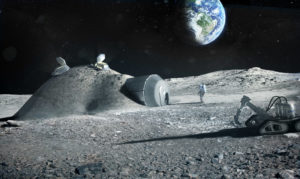Dec
22
2017
 Science continues to kick ass in 2017, despite the fact that it often feels as if our species can’t get out of our own way. Obviously we need to keep our eye on important social and political issues, but it is reassuring to realize that there are many scientists quietly working away in their labs, clinics, observatories, or wherever to nudge our collective knowledge forward.
Science continues to kick ass in 2017, despite the fact that it often feels as if our species can’t get out of our own way. Obviously we need to keep our eye on important social and political issues, but it is reassuring to realize that there are many scientists quietly working away in their labs, clinics, observatories, or wherever to nudge our collective knowledge forward.
Here are some of the science news stories from 2017 that I think deserve notice and give us a good indication of what is to come.
The Age of Genetic Engineering
Genetic engineering is nothing new, but we seem to be on the upswing of an exponential curve with this technology. In recent years CRISPR has provided cheap and fast genetic manipulation, resulting in an explosion of research and potential applications. The technology borrows a system from bacteria used in their immune defense against viruses. It allows for the specific targeting of sequences of DNA which can then be clipped out and even replaced.
CRISPR technology continues to advance on two main fronts – improving the technology itself, and finding applications for it. This year researchers discovered how to adjust the specificity of CRISPR targeting – making it slower but more precise as desired. As powerful as this tech is, we are still on the steep part of the curve and it continues to improve. Continue Reading »
Dec
21
2017
 It seems that bad ideas never truly go away. Whatever cultural or psychological factors favored their rise in the first place may bring them around again and again. A solid debunking may knock them down for a while, but a new generation, ignorant of the past, can resurrect them as needed.
It seems that bad ideas never truly go away. Whatever cultural or psychological factors favored their rise in the first place may bring them around again and again. A solid debunking may knock them down for a while, but a new generation, ignorant of the past, can resurrect them as needed.
I have to say, despite the fact that I am an experienced and even jaded skeptic, the rise of flat-earthers over the last couple of years surprised me. I know that there are no practical limits to self-deception and the distorting effect that a powerful narrative can have on perception and motivated reasoning. But still I can be surprised when new examples push the limits of sloppy thinking.
Now, vying for the title of dumbest pseudoscience to resurrect, we have the apparent return of Lysenkoism in Russia. A recent article in Current Biology details how sympathy for Trofim Lysenko, while still fringe, is on the rise in Russia, apparently riding a wave of anti-Western and pro-Stalin sentiment.
Continue Reading »
Dec
19
2017
 I am not impressed. That is often the reaction I have to hyped reports of alleged evidence for strange phenomena. They never turn out to be truly impressive or exciting. The recently released Pentagon UFO videos are no different.
I am not impressed. That is often the reaction I have to hyped reports of alleged evidence for strange phenomena. They never turn out to be truly impressive or exciting. The recently released Pentagon UFO videos are no different.
The backstory is that it was recently revealed that the Pentagon funded the Advanced Aviation Threat Identification Program for five years with a total of $22 million. The program officially ended in 2012 but apparently its members continued to investigate interesting reports off the books. The former director of this program, Luis Elizondo, pushed to have some of the evidence they uncovered made public, resulting in the release of the video.
Elizondo is a believer. He is quoted as saying:
“I think this is a national security imperative,” Elizondo said. “We have clear things that we do not understand how they work, operating in areas that we can’t control.”
Does all of this add up to the likely conclusion that we are being visited by advanced aliens? I’m doubtful.
First, the existence of the program itself is not even suggestive that we are being visited by aliens. This is a common theme in the UFO community – interpreting typical government secrecy as hiding proof of aliens. The fact is the government does engage in secret programs and tries to cover their tracks. The Roswell incident, for example, was an airforce coverup – of a secret program to spy on Soviet nuclear testing. Area 51 does exist – to test secret spy planes and similarly classified tech.
Continue Reading »
Dec
18
2017
 I received a flood of e-mails over the weekend pointing me to reports that the CDC is banned from using seven words or phrases in their upcoming budget proposals. They are not George Carlin’s famous “seven dirty words” you can never say on television. Rather they are: “vulnerable,” “entitlement,” “diversity,” “transgender,” “fetus,” “evidence-based” and “science-based,” according to the Washington Post, who broke the story.
I received a flood of e-mails over the weekend pointing me to reports that the CDC is banned from using seven words or phrases in their upcoming budget proposals. They are not George Carlin’s famous “seven dirty words” you can never say on television. Rather they are: “vulnerable,” “entitlement,” “diversity,” “transgender,” “fetus,” “evidence-based” and “science-based,” according to the Washington Post, who broke the story.
First let’s discuss the status of these reports – they are not official public statements from the Centers for Disease Control (CDC), the HHS (department of Health and Human Services) or the Trump Administration. They are anonymous reports from CDC officials who were present during a meeting in which the seven unwanted terms were discussed. Apparently this report was confirmed with several people who were present.
CDC Director Brenda Fitzgerald has pushed back against these reports without straight-up denying them.
“I want to assure you there are no banned words at CDC. We will continue to talk about all our important public health programs,” CDC said in a Facebook post. “I want to assure you that CDC remains committed to our public health mission as a science- and evidence-based institution. As part of our commitment to provide for the common defense of the country against health threats, science is and will remain the foundation of our work.”
Meanwhile the HHS stated the reports were a “mischaracterization.”
Continue Reading »
Dec
15
2017
 The gorgeous rings of Saturn are one of the most dramatic features of our solar system, and certainly a favorite of any backyard astronomer. Are they, however, a fixture that have been present for the majority of the life of our solar system, or are they a recent addition?
The gorgeous rings of Saturn are one of the most dramatic features of our solar system, and certainly a favorite of any backyard astronomer. Are they, however, a fixture that have been present for the majority of the life of our solar system, or are they a recent addition?
Of course we have no observations from millions or billions of years ago, so we can only infer their probable age. Up until recently astronomers believed they were probably ancient because the large collisions that likely produced them would have been far more likely in the early crowded solar system. However – recent evidence from Cassini has changed that conclusion.
The Cassini probe made detailed observations of Saturn and its rings for years, until it plummeted into the planet this September. Scientists are still analyzing all the data it sent back home. Two lines of evidence suggest that the rings of Saturn are far younger than previously suspected.
Continue Reading »
Dec
14
2017
 Perhaps one of the most underrated science stories of 2017 was the separation of a massive iceberg the size of Delaware from the Larsen C Ice Shelf in Antarctica. That is because this is not an isolated event, but just a dramatic part of a larger story – the melting of Antarctica.
Perhaps one of the most underrated science stories of 2017 was the separation of a massive iceberg the size of Delaware from the Larsen C Ice Shelf in Antarctica. That is because this is not an isolated event, but just a dramatic part of a larger story – the melting of Antarctica.
Antarctica contains most of the ice on Earth (90%). Much of that ice sits on top of land, unlike Arctic ice which is floating. When floating ice melts it just fills the space that it had displaced. There is a little bit a sea rise due to rising temperatures – water expands as it warms. But this amount of sea rise is small overall. When ice that was sitting on land flows into the ocean, it raises the sea level more significantly.
Antarctica is comprised of glaciers sitting on top of the continent, which itself is mostly below sea level. These glaciers are as thick as three miles. They are divided into a western glacier system and an eastern glacier system. West Antarctica, which is melting faster, contains enough ice to raise the sea level by 14 feet. East Antarctica is more stable but still showing some early signs of melting. All the ice here could raise the sea level by 175 feet.
As the glaciers melt during the warmer months they follow channels out to the ocean. These channels, however, are blocked by ice shelves, which act like a cork, keeping back the ice and helping to maintain the stability of the glaciers.
The ice shelves themselves have a certain structure – they rest on the sea floor but as they extend out from the continent eventually the ice lifts off the sea floor (called the grounding point) and as the ice extends out further it is floating on top of the water. The breakup of these ice shelves is a concern, because that would essentially remove the stopper and greatly accelerate the rate at which glacier melt finds its way to the ocean.
Continue Reading »
Dec
12
2017
 Yesterday President Trump signed Space Policy Directive 1 (SPD1), an executive order that will shape NASAs priorities going forward. Essentially the directive states that NASA’s primary mission is human space exploration, with a specific goal of returning to the moon.
Yesterday President Trump signed Space Policy Directive 1 (SPD1), an executive order that will shape NASAs priorities going forward. Essentially the directive states that NASA’s primary mission is human space exploration, with a specific goal of returning to the moon.
The Directive is the result of recommendations made by the National Space Council (NSC) – a council of experts that advises the executive branch on all matters dealing with space. According to NASA, in June of this year:
President Trump has signed an executive order reestablishing the National Space Council. The council existed previously from 1989-1993, and a version of it also existed as the National Aeronautics and Space Council from 1958-1973. As such, the council has guided NASA from our earliest days and can help us achieve the many ambitious milestones we are striving for today.
The NSC recommended to the White House that NASA’s priority should be the Moon, and SPD1 is the result of that recommendation.
Continue Reading »
Dec
11
2017
 Paltrow has defended her “lifestyle brand” by saying that they are just giving women choices, and being open. Nonsense – don’t be swayed by such distractions.
Paltrow has defended her “lifestyle brand” by saying that they are just giving women choices, and being open. Nonsense – don’t be swayed by such distractions.
I unapologetically support reason and scholarship as critical values for human civilization. This is increasingly true as our world gets more complex, as the stakes get higher, the margins for error lower, and as our culture and economy are increasingly global.
We cannot get by just shooting from the hip. We need people with specific expertise who transparently follow a process that is logically valid and based on evidence. We need standards of scholarship and intellectual rigor that are up to the challenges we face. We also need to make this work within an open and democratic society, where public opinion matters.
What all this means is that it is more important than ever to have a well-educated public, and for our public discourse to respect standards of honesty and excellence. It matters if people understand and accept what experts have to say about vaccine safety and effectiveness, the evidence base for manmade climate change, the safety of GMOs, and the nature of health and disease.
Continue Reading »
Dec
08
2017

If you have not yet read Daniel Kahneman’s book, Thinking, Fast and Slow, I recommend it. I have discussed its basic principles here many times, and I am reminded of it by a new study that evaluates how we quickly size-up groups of people.
Before we get to the study, here is a quick overview. Kahneman and Tversky did the foundational research into cognitive biases and heuristics – ways in which our thinking is biased or constrained. Kahneman calls this system 1 thinking, or intuitive thinking, which is the fast sort. There is also system 2 thinking, which is slow and analytical.
He admits that these are metaphors, there probably aren’t two distinct biological systems in our brains, but they help us think about the different ways in which we think. Actually, given that our brains are hierarchical, the two-system model may be based in biology to some extent. There are the primitive older parts of our brain that are more system 1 – instinctive, emotional, and fast. Then there is the neocortex – which gives us executive function, and slow deliberative decision-making. I don’t think you can make a clean separation, but it is a useful schematic that is probably more true than not.
In any case, the two systems work together to shape our perceptions and decision-making. The idea is that we evolved rapid-response cognitive systems that makes quick and dirty judgments that are accurate enough and biased in whatever direction favors survival. We can then follow up these quick perceptions with more careful analysis when we have time.
Continue Reading »
Dec
07
2017
 If the best available evidence is used to determine which treatment strategy for a serious illness has the best survival, than any “alternative” to this evidence-based treatment should, by definition, have a lower survival.
If the best available evidence is used to determine which treatment strategy for a serious illness has the best survival, than any “alternative” to this evidence-based treatment should, by definition, have a lower survival.
That is a simple and straightforward fact. You have to believe in some twisted conspiracy theory to avoid the obvious conclusion.
But good scientists like to dot all their “i”s and cross all their “t”s. In August Yale researchers published a study in which they looked carefully at the outcomes of cancer patients treated with conventional treatments vs those who opted for so-called alternative treatments. They only considered patient who used alternative treatments instead of proven treatments.
Continue Reading »
 Science continues to kick ass in 2017, despite the fact that it often feels as if our species can’t get out of our own way. Obviously we need to keep our eye on important social and political issues, but it is reassuring to realize that there are many scientists quietly working away in their labs, clinics, observatories, or wherever to nudge our collective knowledge forward.
Science continues to kick ass in 2017, despite the fact that it often feels as if our species can’t get out of our own way. Obviously we need to keep our eye on important social and political issues, but it is reassuring to realize that there are many scientists quietly working away in their labs, clinics, observatories, or wherever to nudge our collective knowledge forward.
 It seems that bad ideas never truly go away. Whatever cultural or psychological factors favored their rise in the first place may bring them around again and again. A solid debunking may knock them down for a while, but a new generation, ignorant of the past, can resurrect them as needed.
It seems that bad ideas never truly go away. Whatever cultural or psychological factors favored their rise in the first place may bring them around again and again. A solid debunking may knock them down for a while, but a new generation, ignorant of the past, can resurrect them as needed. I am not impressed. That is often the reaction I have to hyped reports of alleged evidence for strange phenomena. They never turn out to be truly impressive or exciting. The recently released Pentagon UFO videos are no different.
I am not impressed. That is often the reaction I have to hyped reports of alleged evidence for strange phenomena. They never turn out to be truly impressive or exciting. The recently released Pentagon UFO videos are no different. I received a flood of e-mails over the weekend pointing me to
I received a flood of e-mails over the weekend pointing me to  The gorgeous rings of Saturn are one of the most dramatic features of our solar system, and certainly a favorite of any backyard astronomer. Are they, however, a fixture that have been present for the majority of the life of our solar system, or are they a recent addition?
The gorgeous rings of Saturn are one of the most dramatic features of our solar system, and certainly a favorite of any backyard astronomer. Are they, however, a fixture that have been present for the majority of the life of our solar system, or are they a recent addition? Perhaps one of the most underrated science stories of 2017 was the separation of a massive iceberg the size of Delaware from the
Perhaps one of the most underrated science stories of 2017 was the separation of a massive iceberg the size of Delaware from the  Yesterday President Trump signed
Yesterday President Trump signed  Paltrow has defended her “lifestyle brand” by saying that they are just giving women choices, and being open. Nonsense – don’t be swayed by such distractions.
Paltrow has defended her “lifestyle brand” by saying that they are just giving women choices, and being open. Nonsense – don’t be swayed by such distractions.
 If the best available evidence is used to determine which treatment strategy for a serious illness has the best survival, than any “alternative” to this evidence-based treatment should, by definition, have a lower survival.
If the best available evidence is used to determine which treatment strategy for a serious illness has the best survival, than any “alternative” to this evidence-based treatment should, by definition, have a lower survival.




